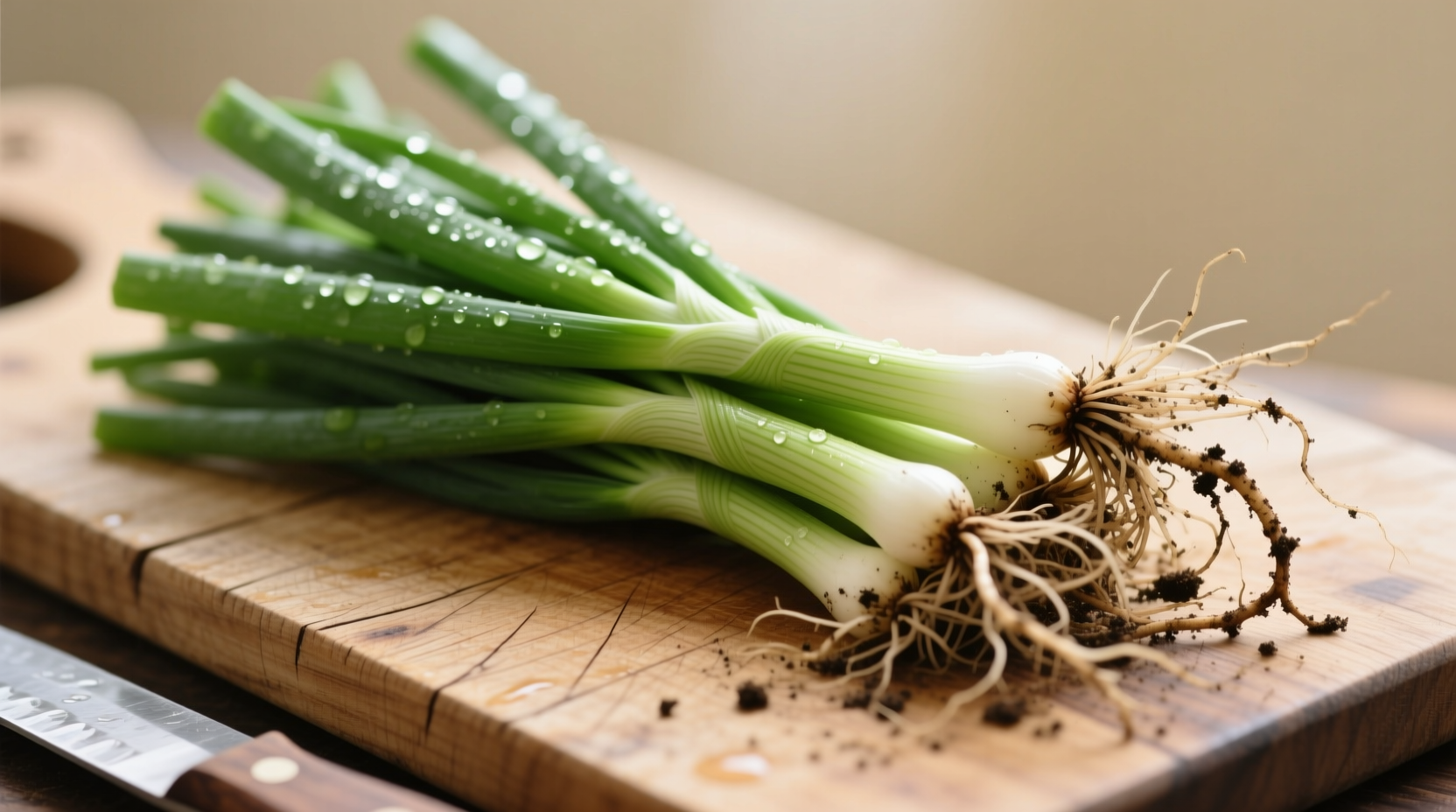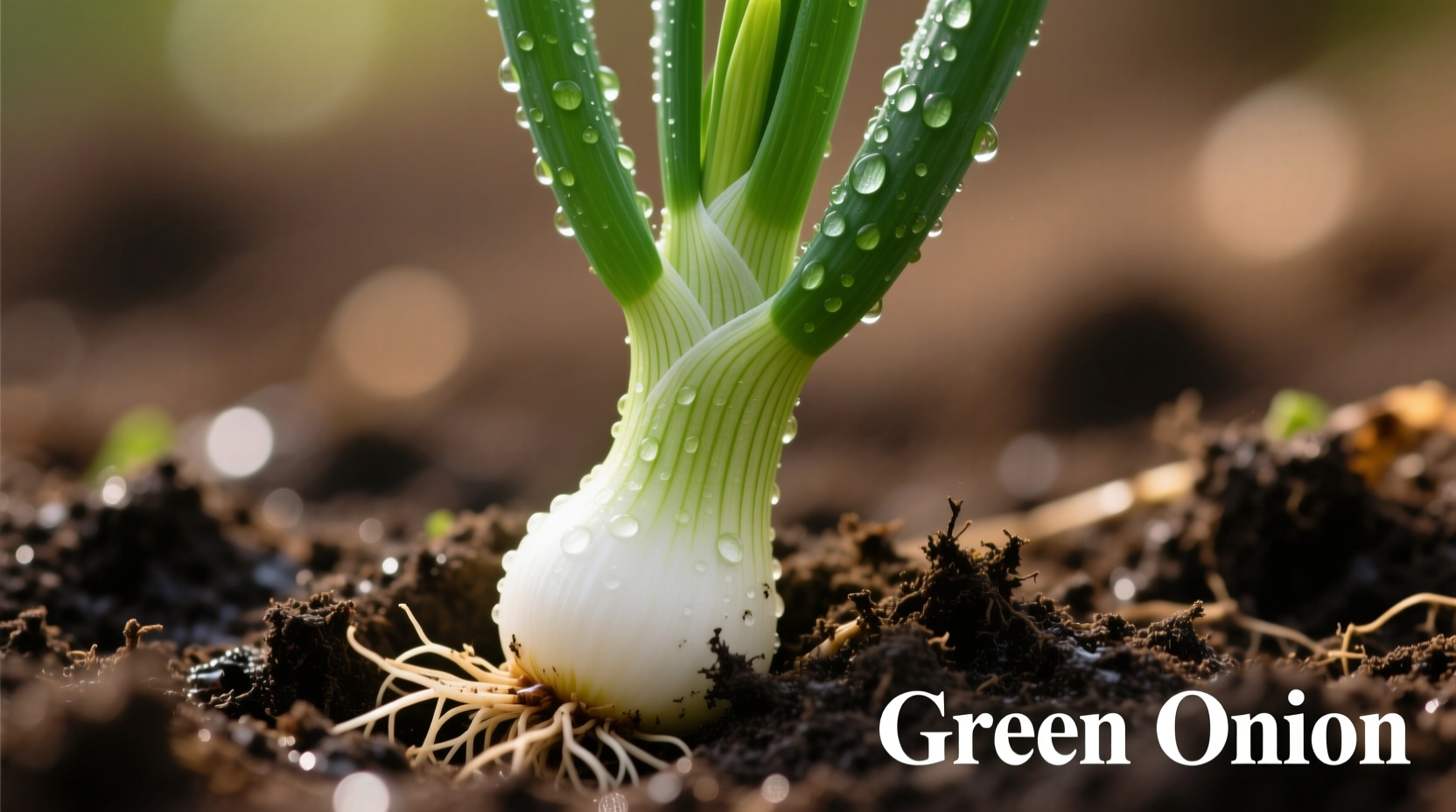Green onions, also known as scallions or spring onions, are young onion plants harvested before the bulb fully develops. They feature long green stalks and small white bulbs with roots, providing a mild onion flavor essential in global cuisines. This visual guide helps you accurately identify green onions, distinguish them from similar vegetables, and select the best specimens for cooking.
What Exactly Is a Green Onion? Visual Identification Essentials
When searching for green onion image references, you need clear visual markers to distinguish these versatile vegetables from similar alliums. Green onions (Allium fistulosum) are harvested early in their growth cycle, typically 60-90 days after planting, before the bulb fully forms. This timing creates their distinctive appearance that chefs and home cooks rely on for accurate identification.
The most reliable visual characteristics include:
- Color gradient - Deep green tops fading to pale green, then white at the base
- Bulb structure - Small, elongated white bulb (never fully rounded like mature onions)
- Root system - Visible white roots still attached (when purchased fresh)
- Diameter consistency - Generally uniform thickness from bulb to stem

Green Onion Identification: Key Visual Markers
Understanding the precise visual characteristics of green onions prevents common kitchen mistakes. Unlike mature onions, green onions maintain their cylindrical shape throughout the stalk, with no significant bulb enlargement. The white portion should measure 1-3 inches in length, while the green stalks typically reach 8-12 inches.
| Visual Characteristic | Green Onion | Common Confusion Points |
|---|---|---|
| Color Transition | Gradual fade from deep green to white | Chives maintain uniform green color |
| Bulb Development | Small, elongated white base (1-3 inches) | Shallots have distinct rounded bulbs |
| Root Appearance | Fresh specimens have white roots attached | Leeks often have roots trimmed |
| Stem Texture | Hollow, cylindrical green portion | Garlic chives have flat, solid stems |
Seasonal Variations in Green Onion Appearance
Green onions change appearance throughout the growing season, affecting their visual identification. Understanding these seasonal variations helps you select the best specimens year-round:
- Spring harvest - Tender, thinner stalks with delicate flavor (ideal for salads)
- Summer harvest - Slightly thicker stalks with more pronounced onion flavor
- Fall harvest - Heartier stalks that withstand cooking better
- Winter varieties - Often grown indoors with consistent appearance year-round
According to the USDA Agricultural Research Service, the diameter of green onion stalks typically ranges from ¼ to ½ inch, with larger diameters indicating more mature specimens that have stronger flavor profiles. This measurement provides a reliable visual cue when selecting green onions at markets.
Practical Identification Scenarios
Visual identification matters most in specific culinary contexts where substituting similar vegetables would alter dish outcomes:
- Asian cuisine applications - Authentic stir-fries require true green onions, not substitutes
- Garnishing delicate dishes - Milder green onions won't overpower subtle flavors
- Raw preparations - Proper identification prevents accidentally using stronger alliums
- Gardening verification - Ensuring you're harvesting the correct plant variety
When shopping for green onions, look for specimens with crisp, vibrant green tops and firm white bases. Avoid any with yellowing tips, soft spots, or dried-out roots. The best green onions feel firm throughout the stalk and show no signs of wilting. These visual quality indicators directly correlate with flavor intensity and shelf life.
Common Visual Misidentifications and Their Consequences
Mistaking similar alliums for green onions can significantly impact your cooking results. The University of California Cooperative Extension notes that confusing leeks with green onions is particularly common among novice cooks, leading to unexpected flavor intensities in dishes.
Welsh onions (a specific green onion variety) maintain their cylindrical shape even when mature, while regular green onions develop small bulbs if left in the ground too long. This subtle visual difference affects both flavor profile and culinary applications. When searching for green onion image references, pay special attention to the bulb-to-stem transition point, which provides the most reliable identification marker.
Using Visual Identification for Culinary Success
Proper visual identification directly impacts your cooking outcomes. The green portion provides mild onion flavor with grassy notes, while the white portion offers more pronounced onion taste. When a recipe specifies 'green parts only' or 'white parts only,' accurate visual identification becomes crucial.
Professional chefs at the Culinary Institute of America emphasize that understanding these visual distinctions allows for precise flavor control. For delicate sauces and dressings, using only the green portions creates subtle onion notes without overwhelming other ingredients. In stir-fries and sautéed dishes, the white portions provide necessary aromatic foundation.
Preserving Visual Quality After Purchase
Maintaining the visual characteristics of green onions extends their usability. Store them upright in a glass of water in the refrigerator, changing the water every two days. This method preserves their crisp appearance and prevents yellowing. Properly stored green onions maintain their visual quality for 7-10 days, according to food safety research from Cornell University.











 浙公网安备
33010002000092号
浙公网安备
33010002000092号 浙B2-20120091-4
浙B2-20120091-4